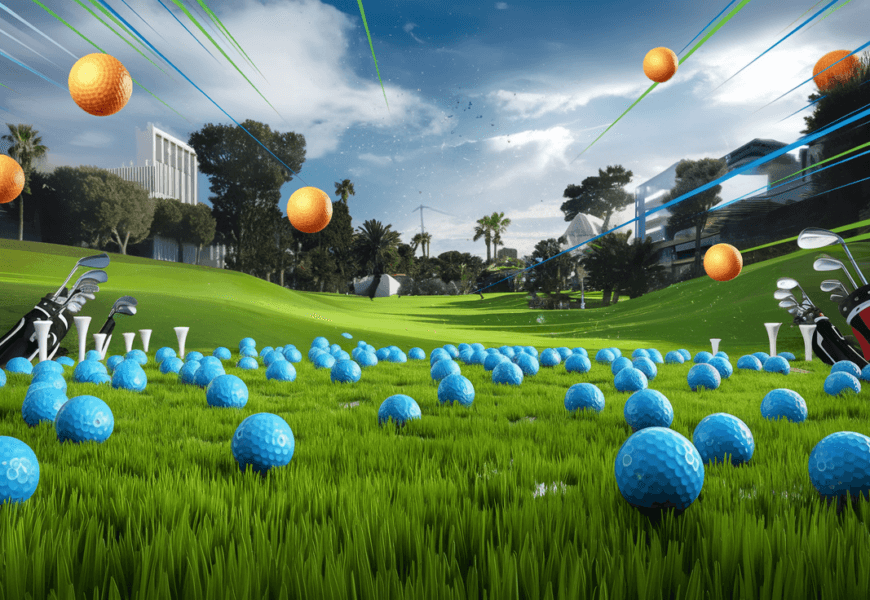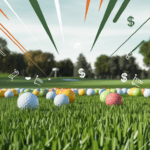The World of Colored Golf Balls
Evolution of Colored Golf Balls
Back in the ’70s, colored golf balls took their first swing onto the scene. These flashy high-optic yellows and oranges weren’t just about style—they helped players see the ball better. Turns out, these bright colors are like neon signs to our eyes. Top brands like Titleist and Callaway saw the value and jumped onboard, giving golfers more reasons to love the game.
Over the years, the paint box has expanded beyond just yellow and orange. You can spot golf balls in all sorts of snazzy colors now—think pink, green, and even some wild multi-colored designs. While some golfers choose them for the sheer fun and variety, others find they help keep their eye on the ball a bit more easily during a round.
Benefits of Colored Golf Balls
Choosing colored golf balls isn’t just about making a fashion statement on the links. First up, they’re a breeze to track. Whether your ball’s skidding across the fairway or nestled awkwardly in the rough, those bright hues really stand out, even against a moody sky. Yellow, in particular, is a fan favorite for this reason.
But there’s more than meets the eye—literally. The rainbow of options can subtly boost your mental game too. Some players find that a bright ball lightens up the mood and takes a bit of the edge off during play, which can actually help their game.
Of course, golf ball makers are no slouches—they’ve cleverly used color as a hook to lure more players into the fold. These eye-catching balls are big hits at golf events and also make great personalized gifts. You can discover more personalized options here.
| Color | Popularity | Visibility |
|---|---|---|
| Yellow | En Vogue | Top-Notch |
| Orange | Fairly Popular | Solid |
| Pink | Niche | Good Enough |
| Green | Less Fancied | Okay-ish |
Colored golf balls aren’t just a fleeting fad. They’re practical, often giving you a better view of your shot and a little extra pep in your step. As the golfing gears keep turning, you can bet these bright balls will keep bouncing into the spotlight. Curious about which balls give you that extra yardage in your swing? Check our distance ball guide for more.
Visibility and Performance
The Science Behind Visibility
Let’s chat a bit about colored golf balls. Unlike traditional white golf balls, these little nuggets of color are making waves for a big reason—visibility. Research tells us that colored balls, particularly green and yellow, are easier to track in the air and spot on the ground. In fact, you can keep an eye on a colorful ball nearly 50% better than its white counterpart, especially on those long 200-yard drives. The contrast these colors have against the backdrop of the course makes all the difference when you don’t want to send out a search party after every swing.
Impact on Performance Factors
Brightly colored golf balls don’t just look pretty; they can actually help you play better by cutting down on lost balls and making it easier to follow your shot.
Key Performance Factors:
Distance Tracking:
Ever tried to follow a ball 250 yards out? Yellow balls seem to have a homing beacon, being three times easier to track compared to white ones (Glenmuir).Recovery Rate:
Bright colors up your game by helping you find balls more easily, even in tricky conditions, slashing the number of lost balls.Spin Dynamics:
The Srixon Z-Star Divide has a unique split-color design, which lets you clearly see the spin during flight and makes lining up a putt with more accuracy a breeze (Rock Bottom Golf).
| Golf Ball Color | Visibility (out of 10) | Distance Tracking (yards) | Spin Dynamics |
|---|---|---|---|
| Yellow | 9 | 250 | High |
| Orange | 8 | 225 | Moderate |
| Pink | 7 | 200 | Low |
| White | 6 | 180 | Low |
High visibility colored balls outshine regular white ones in many scenarios (Rock Bottom Golf). For more tips on finding the perfect golf ball for your game, check out our articles on best golf balls for high handicappers and golf balls for beginners.
Popular Colored Golf Balls
When I think about colored golf balls, yellow, orange, green, and pink pop up in my mind for their visibility and popularity. Each color has its perks and can really change the way I play.
Yellow Golf Balls
Yellow golf balls are a hit among players and brands like Titleist, Callaway, Bridgestone, and Srixon. They’re three times easier to see from a long way off and can be spotted at a whopping 250 yards better than any other color. Titleist even jumped on the bandwagon, releasing the Pro V1 and Pro V1x in a bright, high-optic yellow. Looks like these bright yellow orbs are here to stay, especially with the pros adopting them.
Orange and Green Golf Balls
Orange and green balls are my go-tos when I need a little contrast. Orange is perfect for those cloudy days or when the leaves start to fall, standing out brilliantly against blue skies and green fairways. Green balls showed up on the scene thanks to Srixon in the mid-2000s and have been a solid choice for bright, sunny playtimes. Seeing how successful these green balls have been, Callaway and the like came up with their green versions, adding more color to the game.
| Golf Ball Color | Visibility Conditions |
|---|---|
| Yellow | Super visible, easy to track from afar (250 yards) |
| Orange | Sticks out in the sky and against greenery |
| Green | Stays bright on clear, sunny days |
Pink Golf Balls
Pink balls have their own charm and story. They made their debut big time back in ’93 at the LPGA Tour’s Phar-Mor event, supporting breast cancer research—a cause close to many hearts. The pink ball fever caught on, and in 2001, Wilson rolled out their ‘Hope’ pink ball to back the fight against breast cancer. Loads of other companies jumped on board, crafting pink balls for charity, adding heart to the game.
Choosing a color isn’t just about looks, it’s got a lot to do with how colors mess with our heads too. I dive into the colorful psychology in a section on choosing the right color. Curious about more gear for specific needs? Check out our pieces on golf balls for women and best golf balls for high handicappers.
Choosing the Right Color
Picking the perfect color for your golf ball isn’t just about looking good on the greens. Color can change the way you play in some surprising ways, from how well you keep track of the ball to even how you feel while you’re swinging away.
Factors to Consider
Getting the color right could give your golf game a nice little boost. Here’s some stuff to think about:
- Visibility:
- It turns out you’re almost twice as likely to keep your eye on a bright-colored golf ball in the air versus your standard white one on a 200-yard drive (Thanks, Golfballs.com).
- Yellow balls top the list, being three times easier to notice than others at 250 yards (Glenmuir).
- Whether they’re soaring or chilling on the grass, yellow and green ones are the easiest to find.
- Performance:
- The pigments that color your ball can mess with how it performs, but it’s nothing major (GolfWRX Forum).
- Orange balls, for instance, have a tiny bit of extra hardness compared to other neon ones.
| Color | Visibility | Performance | Notes |
|---|---|---|---|
| Yellow | High | Consistent | Easiest to keep an eye on |
| Green | High | Consistent | Stands out in any setting |
| Orange | Medium | Harder | A touch more firmness |
| Pink | Medium | Consistent | Eye-catching and fun |
Psychologic Effects of Colors
Colors aren’t just eye candy; they mess with your brain too—sometimes in good ways:
- Excitement and Energy:
- Red, orange, and yellow give off vibes of excitement and energy. Grab one of these, and you might just get that extra zing you need out there (Glenmuir).
- Calm and Peacefulness:
- Blue and green are all about calmness and peace. Perfect for staying chill and zen when you’ve got those high-pressure shots lined up.
Check out our dives into the nitty-gritty of best golf balls for distance and high spin golf balls for more deets. Knowing your colors and how they stack up can really help you dial in what feels right, making you the smoothest golfer on the course.
Color vs. Traditional
Alright, let’s talk about the colorful swap from the classic white golf balls, and how that can ramp up my game without needing a pro-level swing.
Visibility Comparison
Seeing those pesky little golf balls is the name of the game. Choosing one in a high-vis color instead of the plain ol’ white can make all the difference.
| Type of Golf Ball | How Easy to See? |
|---|---|
| White | Best for clear skies and open fairways |
| Yellow | Easy peasy to spot even when it’s out there far away (Glenmuir) |
| Orange and Green | Great for those green-y fairways or when it’s a bit cloudy |
| Pink | Perfect for blending in, super popular at charity events (Clean Green Golf Balls) |
Picking the right shade can up my game by making sure I actually locate the ball when it disappears into the great beyond. Like, those yellow ones? They’re visible from like, 250 yards! (Glenmuir).
Performance Differences
Now, let’s dig into how they actually perform on the course, because it’s not just about looking good.
| Performance Bit | Colored Golf Balls | Boring, I mean, Classic White Ones |
|---|---|---|
| Distance | Hits about the same, but easier to track those long ones | Standard going distance |
| Spin | Spins just like the white ones, helps me control better | Usual spin vibes |
| Feel | Feels alike, kinda gives a confidence boost that helps me swing like I mean it (Golfballs.com) | What everyone’s used to |
Switching to a pop of color can do wonders for my on-course mojo, letting me swing smoother and smack the ball where I really want. And truly, it’s easier on the eyes to spot where it lands (Golfballs.com).
Craving more guidance on picking the perfect ball? Check out our write-ups on everything from customized golf balls to max-distance wonders, and even low spin magicians. These will arm me with all the know-how I need for the greens.
Market Trends and Future
Interest in colored golf balls is hitting an all-time high, transforming this once niche market. Let’s take a closer look at how these lively golf balls are getting along with the industry and what lies ahead.
Industry Acceptance of Colored Balls
Colored golf balls have blossomed in popularity over the years. Initially met with hesitation, they’ve now become a staple for players of all abilities. The first step into the colorful world was taken when Spalding introduced the “Executive,” a yellow ball, in the 1970s. But it wasn’t until 1984, when Titleist rolled out the yellow Titleist Professional 90, that the market really took a shine to them (Clean Green Golf Balls).
Nowadays, top brands like Callaway, Bridgestone, Srixon, Titleist, and TaylorMade offer a spectrum of hues to suit various tastes. These companies have wisecracked that adding color to their lineups broadens the market and invites more folks to the fairway (Golf Ball Planet). The way different colors can lift excitement, bring energy, or instill calm also helps boost their popularity (Glenmuir).
Outlook for Colored Golf Balls
The future for colored golf balls looks bright—literally and figuratively. With the push for better visibility and bespoke choices, these colored gems are set to hold their ground and even expand in favor. Yellow ones, in particular, stand out for their high visibility, making them a top choice, especially when daylight wanes.
Expect even more colorful innovation as manufacturers play around with new shades and fine-tune the classics, giving golfers a palette to pick from. With used colored balls also available for less, trying out different colors won’t break the bank (Found Golf Balls).
Golfers ready to dive into the colorful side can look at the range of options available, tailored to styles and preferences. From distance to spin and feel, there’s a ball to help up your game and enjoyment.
| Golf Ball Type | Key Perks |
|---|---|
| Yellow Golf Balls | Easier to see when it’s a bit dark |
| Orange and Green Golf Balls | Stand out and catch the eye |
| Pink Golf Balls | Offer something visually unique with a softer touch |
With tech on the rise and ever-shifting market vibes, colored golf balls are in for a real shake-up, giving golfers a rainbow of options to explore.
For more deets on different kinds of golf balls, check out our articles on low spin golf balls, best golf balls for high handicappers, and golf balls for beginners.



